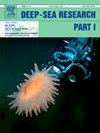Potential carbon sources and sinks in frontal zones dominated respectively by mesoscale and submesoscale processes in the Luzon Strait
IF 2.1
3区 地球科学
Q2 OCEANOGRAPHY
Deep-Sea Research Part I-Oceanographic Research Papers
Pub Date : 2025-02-10
DOI:10.1016/j.dsr.2025.104461
引用次数: 0
Abstract
The Luzon Strait experiences active ocean fronts resulting from the intrusion of the Kuroshio water, accompanied by substantial mesoscale and submesoscale processes. These processes induce variable patterns of upwelling and downwelling where submesoscale dynamics are often more intense than their mesoscale counterparts, profoundly affecting phytoplankton production and sedimentation. However, the ultimate role of these processes in the production and export of carbon remains unclear. We analyzed daily satellite and reanalysis data from 1999 to 2019, revealing the climatological patterns and spatial variations of mesoscale and submesoscale processes during both summer and winter, thereby identifying distinct frontal zones dominated by either mesoscale or submesoscale processes. Our results show that the cyclonic front area on the eastern side of the strait and anticyclonic front area along the Kuroshio axis, are significantly influenced by submesoscale processes. These areas are identified as potential carbon sinks due to enhanced nutrient availability and elevated sedimentation rates. Conversely, although mesoscale fronts contribute more significantly to Chlorophyll-a, the cyclonic front area on the western side of the strait, dominated by mesoscale processes, serves as a potential carbon source. This difference is attributed to the slower sedimentation rate of organic matter in the mesoscale region, which prolongs the decomposition of both in-situ and horizontally transported matter. These findings deepen our understanding of the impacts of mesoscale and submesoscale processes within frontal zones on the global carbon cycle.
吕宋海峡锋面区潜在碳源和碳汇分别受中尺度和亚中尺度过程的支配
由于黑潮的入侵,吕宋海峡经历了活跃的洋锋,并伴有大量的中尺度和亚中尺度过程。这些过程引起了上升流和下升流的变化模式,其中亚中尺度动力学通常比中尺度动力学更强烈,深刻地影响了浮游植物的生产和沉积。然而,这些过程在碳生产和出口中的最终作用仍不清楚。我们分析了1999 - 2019年的每日卫星和再分析数据,揭示了夏季和冬季中尺度和亚中尺度过程的气候模式和空间变化,从而确定了以中尺度或亚中尺度过程为主的不同锋面区。结果表明,海峡东侧的气旋锋区和黑潮轴沿线的反气旋锋区受到亚中尺度过程的显著影响。这些地区由于营养物质可用性增强和沉积速率升高而被确定为潜在的碳汇。相反,虽然中尺度锋对叶绿素-a的贡献更大,但以中尺度过程为主的海峡西侧气旋锋区是潜在的碳源。这种差异是由于中尺度区域有机质沉积速度较慢,从而延长了原位和水平输送物质的分解时间。这些发现加深了我们对锋面区中尺度和亚中尺度过程对全球碳循环影响的理解。
本文章由计算机程序翻译,如有差异,请以英文原文为准。
求助全文
约1分钟内获得全文
求助全文
来源期刊
CiteScore
4.60
自引率
4.20%
发文量
144
审稿时长
18.3 weeks
期刊介绍:
Deep-Sea Research Part I: Oceanographic Research Papers is devoted to the publication of the results of original scientific research, including theoretical work of evident oceanographic applicability; and the solution of instrumental or methodological problems with evidence of successful use. The journal is distinguished by its interdisciplinary nature and its breadth, covering the geological, physical, chemical and biological aspects of the ocean and its boundaries with the sea floor and the atmosphere. In addition to regular "Research Papers" and "Instruments and Methods" papers, briefer communications may be published as "Notes". Supplemental matter, such as extensive data tables or graphs and multimedia content, may be published as electronic appendices.

 求助内容:
求助内容: 应助结果提醒方式:
应助结果提醒方式:


